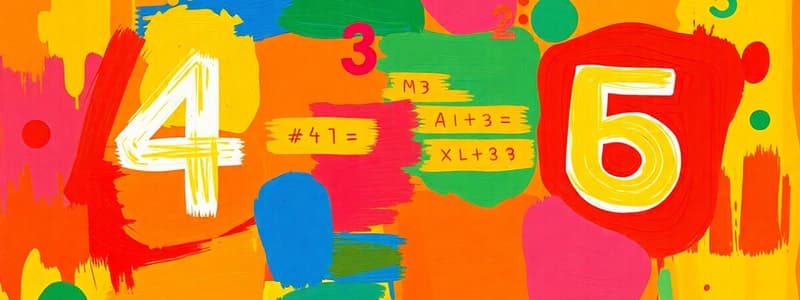Podcast
Questions and Answers
What is skip counting and give an example?
What is skip counting and give an example?
Skip counting is counting by a number other than one. For example, counting by 5s: 5, 10, 15, 20.
How do you perform subtraction and provide an example?
How do you perform subtraction and provide an example?
Subtraction involves taking one number away from another. For example, $5 - 2 = 3$.
Explain place value in the number 67.
Explain place value in the number 67.
In 67, 6 is in the tens place and represents 60, while 7 is in the units place representing 7.
What are the names of the basic shapes and give two examples?
What are the names of the basic shapes and give two examples?
How do you determine which object is heavier?
How do you determine which object is heavier?
What is the importance of reading clocks?
What is the importance of reading clocks?
What is a basic word problem and its importance?
What is a basic word problem and its importance?
What is an example of identifying a pattern?
What is an example of identifying a pattern?
Flashcards are hidden until you start studying
Study Notes
Basic Kids Maths Study Notes
Numbers and Counting
- Counting: Children learn to count sequentially (1, 2, 3...) and recognize numbers.
- Number Recognition: Identifying and naming numbers from 0-100.
- Skip Counting: Counting by 2s, 5s, and 10s.
Basic Operations
- Addition:
- Combining two or more numbers to get a sum.
- Example: 2 + 3 = 5.
- Subtraction:
- Taking one number away from another to find the difference.
- Example: 5 - 2 = 3.
- Multiplication:
- Repeated addition of the same number.
- Example: 4 x 3 = 12 (4 added three times).
- Division:
- Splitting a number into equal parts.
- Example: 12 ÷ 4 = 3 (12 divided into 4 equal groups).
Place Value
- Understanding Place Value: Recognizing the value of digits based on their position (units, tens, hundreds).
- Example: In 54, 5 is in the tens place and represents 50, while 4 is in the units place.
Shapes and Geometry
- Basic Shapes: Recognizing and naming shapes like circles, squares, triangles, and rectangles.
- Attributes of Shapes: Understanding properties such as sides, corners, and symmetry.
Measurement
- Length: Understanding concepts of longer and shorter.
- Weight: Identifying heavier and lighter objects.
- Volume: Recognizing full and empty containers.
Time
- Reading Clocks: Understanding analog and digital clocks.
- Days of the Week: Learning the names and order of days.
- Months of the Year: Recognizing and sequencing the months.
Money
- Identifying Coins: Learning to recognize and name different denominations (pennies, nickels, dimes, quarters).
- Basic Transactions: Simple addition and subtraction involving money.
Word Problems
- Understanding Context: Learning to interpret and solve problems presented in words.
- Problem-Solving Strategies: Using drawings, objects, or equations to find solutions.
Patterns
- Identifying Patterns: Recognizing repeating sequences in shapes, colors, or numbers.
- Creating Patterns: Engaging in activities to create and extend patterns.
Fun Activities
- Games: Engaging with math through board games, card games, and online math games.
- Hands-On Activities: Using manipulatives like blocks or beads for counting and simple operations.
Numbers and Counting
- Counting involves sequential numbers (1, 2, 3...) and is foundational for number skills.
- Number Recognition is crucial for identifying numbers between 0 and 100, helping with reading and understanding quantity.
- Skip Counting includes counting in intervals, such as by 2s (2, 4, 6), 5s (5, 10, 15), and 10s (10, 20, 30), enhancing multiplication skills.
Basic Operations
- Addition is the process of combining numbers to form a total, illustrated by 2 + 3 = 5.
- Subtraction involves removing quantities to find the difference, shown by 5 - 2 = 3.
- Multiplication equates to repeated addition, for example, 4 x 3 translates to 4 added three times yielding 12.
- Division refers to partitioning a number into equal parts; for instance, 12 ÷ 4 results in 3 equal groups.
Place Value
- Understanding Place Value entails recognizing the worth of digits based on their position, such as in 54 where 5 represents 50 in the tens place and 4 signifies 4 units.
Shapes and Geometry
- Basic Shapes include identifying common figures like circles, squares, triangles, and rectangles.
- Attributes of Shapes involve recognizing characteristics such as the number of sides, corners, and the concept of symmetry.
Measurement
- Length involves concepts of longer and shorter for comparing distances.
- Weight helps children differentiate between heavier and lighter objects through practical examples.
- Volume includes understanding concepts of full and empty in relation to containers.
Time
- Reading Clocks includes familiarization with both analog and digital time-telling methods.
- Days of the Week necessitates learning the names and sequential order of each day.
- Months of the Year requires recognizing and sequencing the twelve months.
Money
- Identifying Coins focuses on distinguishing different denominations like pennies, nickels, dimes, and quarters.
- Basic Transactions engage children in simple addition and subtraction exercises using money concepts.
Word Problems
- Understanding Context enables children to interpret and solve problems articulated in sentences or stories.
- Problem-Solving Strategies encourage utilizing drawings, objects, or equations to approach solutions effectively.
Patterns
- Identifying Patterns involves recognizing sequences that repeat in shapes, colors, or numbers, promoting analytical thinking.
- Creating Patterns allows children to participate in activities that develop and extend visual and numerical patterns.
Fun Activities
- Games incorporate math learning through interactive board games, card games, and online math platforms, making learning enjoyable.
- Hands-On Activities use manipulatives like blocks or beads to facilitate counting and performing simple operations, enhancing tactile learning experiences.
Studying That Suits You
Use AI to generate personalized quizzes and flashcards to suit your learning preferences.




